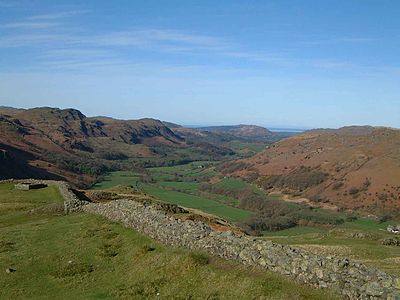Eskdale, Cumberland

Eskdale is a glacial valley in western Cumberland, the valley of the River Esk. It is a sparsely populated place, with about 260 inhabitants.
The dale is in the Ward of Allerdale above Derwent, not Eskdale Ward, which is named after the Dumfriesshire Esk.
One of the Lake District's most popular tourist attractions, the Ravenglass and Eskdale Railway, runs through the valley, though along with other western valleys of the Lake District, Eskdale is notably quieter during the high summer season than the more accessible eastern areas.
Geography
The River Esk flows through the valley to its estuary at Ravenglass. The valley is notable in being one of few major valleys in the Lake District not to have its own lake, although several tarns are perched above the valley sides.
The main access to the valley is from the western end; however, there is also a steep pass with a motor road leading out of the valley to the east over Hardknott Pass, as well as a road with beautiful views leading southwards over Birker Fell to the village of Ulpha in the Duddon Valley.
Alfred Wainwright in his guide "Walks from Ratty" describes Eskdale as "One of the loveliest of Lakeland's valleys, descends from the highest and wildest mountains in the district to the Sands of Ravenglass in a swift transition from bleak and craggy ridges to verdant woodlands and pastures watered by a charming river." Upper Eskdale is a remote wilderness surrounded by Scafell, Scafell Pike, Ill Crag, Esk Pike, Bow Fell and Crinkle Crags; the Woolpack walk takes in this classic horseshoe.
Geology
In June 2012, it became clear that Eskdale (specifically the Eskdale granite formed in the Ordovician Period around 450 million years ago) has been identified as a potential site for a Geological Disposal Facility for the United Kingdom's high level nuclear waste. Two other sites have also been identified - Ennerdale and the Solway Plain. Eskdale was not named by the Managing Radioactive Waste Safely (MRWS) Partnership, rather they referred to the 'granitic rocks forming part of The Lake District Batholith'. These are the Ennerdale and Eskdale granites. This was in (publicly available) document 285 of the West Cumbria MRWS in a report written by Dr Dearlove, the consultant geologist recruited by MRWS.
Outside links
| ("Wikimedia Commons" has material about Eskdale, Cumberland) |
